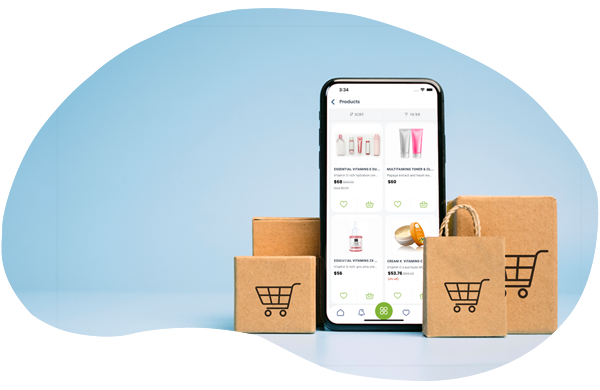Let’s talk about the time before the invention of coffee machines. Remember those days of yore when making an aromatic morning brew was a ritual?
Grind the beans,
carefully measure the grounds, and
brew the perfect cup.
It was a hands-on process.
But then came the coffee machine, simplifying the coffee-making experience. It made your favorite brew available at the push of a button, much like how Direct-To-Consumer (DTC) model has simplified shopping.
Before the era of DTC, shopping for products often felt like manually grinding and brewing your morning coffee—a bit of a process. You had to navigate through intermediaries, like wholesalers or retailers, making the experience somewhat complex.
Much like the coffee machine evolved with integration of smart technology to simplify your morning coffee ritual, DTC trends have made their debut to streamline your shopping experience. These direct to consumer trends enable brands to establish data-driven marketing campaigns, attract new customers and foster brand loyalty.
How DTC works?
DTC is a modern retail model. Here, businesses sell their products or services directly to customers, bypassing traditional middlemen. In this approach, the brand is responsible for marketing, sales, and distribution by utilizing ecommerce platforms and online marketing strategies to reach and engage with customers directly.
With the emergence of new technologies and shifting customer preferences, staying ahead of the curve is not just a choice, but rather a necessity. DTC trends are the solution. They introduce a dynamic approach in direct selling by enabling businesses to establish direct and robust connections with their customer base. So, in this era of heightened customer expectations, the power of DTC cannot be overstated. This is precisely where Epixel MLM Software excels—always vigilant, always ready to adapt and evolve, ensuring that your direct selling business thrives in harmony with the DTC trends.
2025 trends in DTC
It puts you in the driver's seat.
The trend is set, and companies now concentrate more on enhancing customer relationship management, leveraging data-driven shopping, and offering personalized experiences. DTC trends have become increasingly popular, especially in industries like fashion, beauty, and consumer goods.
Let’s now take a closer look at how these 10 DTC trends act as a caffeine fix that direct selling companies can tap into in order to brew the perfect cup of success.

1. Live shopping experience
Searching for the perfect outfit can indeed be a daunting task. The never-ending scrolling, wish lists that seem to grow endlessly, and the frustration of not finding what you truly desire—it's a familiar shopping struggle. To put an end to your shopping fatigue and save you precious time, there's a solution on the horizon.
You may have noticed those inviting notifications that occasionally pop up on your device: "There's a livestream shopping event going on. Excited to join?" Have you ever clicked it? If so, then you're in for a treat—the chance to pick your outfit for the day. And it's just as easy as it sounds.
It’s more than just a convenient way to discover modern fashion ideas. Much like a live concert or red-carpet event, live shopping streams offer a sense of immediacy and interactivity. It includes seeking personalized recommendations, interactions with distributors in real-time, asking questions, community building, and post-purchase engagement. It's a shopping experience that is much different from the impersonal nature of traditional online shopping.
Feedback loop
According to a recent study by Forbes, in the United States in 2022, live shopping generated approximately $20 billion in revenue, representing 2% of the ecommerce market and 0.3% of the total retail market.

The figures highlight the emerging significance of live shopping in the region. Beyond the immediate advantages of real-time product showcases and answering customer queries, this live shopping trend fosters stronger distributor-customer relationships by significantly boosting loyalty and credibility.
2. Social commerce
Social commerce is all about placing the customer at the heart of the sales journey. Through social commerce, direct selling companies leverage social media platforms effectively to connect, build trust, and acquire customers by understanding their preferences. With just a few taps on a screen, brands can keep their customers informed about every exciting new product hitting the market.
Why social commerce matters in DTC marketing?

Direct connection: Brands can engage with their audience in real-time by answering questions, providing product details, and offering personalized recommendations.
Customer-centric approach: It aligns perfectly with a customer-centric approach. From discovery to purchase, everything happens within social media, enhancing the overall shopping experience.
Driving conversions: When customers see products they love within their social feeds, they can make quick and informed purchase decisions. It taps into the impulse-buying behavior of customers, turning likes and shares into tangible sales. This instant satisfaction leads to increased conversion rates and revenue for brands.
Lead generation: Social commerce strategies are highly effective in generating high-quality leads. Brands can identify potential customers through targeted sales tools and engagement strategies. Distributors, in particular, leverage social networks to identify potential customers and nurture relationships over time.
Analytics and insights: The data generated through social commerce is a goldmine of insights. Brands can analyze customer behavior, preferences, and trends to refine their marketing strategies and product offerings.
A robust social presence cultivates brand credibility and fosters customer loyalty by offering seamless shopping experience, improved customer engagement, and product updates reaching the right people at the right time.
3. The influencer effects
The sands of retail industry are changing. Traditional ads no longer grab customers’ attention or trust. As customers today crave
- authenticity,
- personalization, and
- relatability,
businesses are partnering with a new breed of collaborators, often known as influencers. No matter how they are known to this world; trendsetters, brand ambassadors, content creators, or social media stars, it is affirmative that they are reshaping the industry.
When it comes to network marketing, distributors are the micro-influencers who endorse products within their niches as they tap into the trust they've built with their customers. This trust is invaluable as it provides more space for recommendations. Customers believe in the authenticity and sincerity of these micro-influencers, knowing that their suggestions align with individual needs and preferences.
These are the two layers of influence converge who work together to create a compelling shopping experience for customers.

Distributors take up the role of trusted guides who lead customers toward products that genuinely suit their needs.

Mainstream influencers generate excitement and interest around these products on a broader scale.
A robust social presence cultivates brand credibility and fosters customer loyalty by offering seamless shopping experience, improved customer engagement, and product updates reaching the right people at the right time.
4. Content marketing
Content is the king, especially in DTC marketing. It is the storyteller, educator and bridge between the brand and its customers. Let’s see the story of the content marketing.
The ongoing saga – Can it build long-term relationships with audience, making them eager to follow the company’s story for years to come?
To sum it up, the art of content marketing needs thorough market research for businesses right from startups to enterprise levels. Organizations must understand customer pain points and preferences to create content that resonates with them.
5. Digital storefronts
What adds more to the sweet tale of waiting for your favorite ice cream? Yes, that’s right. The toppings hold the promise of enhancing your ice cream adventure. So, will you go for the classic chocolate sauce, caramel drizzle or crushed pretzels? The possibilities are endless, and the choice is yours.
Shopping at an online storefront is just like topping your ice cream. It makes your shopping experience as unique as your taste in ice cream.
Storefront is the digital face of DTC retail. They are like online shops with interfaces or webpages where businesses showcase and sell their products or services to customers on the internet. They serve as the online equivalent of physical retail stores.
Key components to look-out for in storefronts

Product display with images, prices, and relevant information.

User-friendly navigation to explore products with simple menus, search, and filters.

Personalize your experience by suggesting products based on your history.

Shopping carts for customers to gather products, review choices, and make adjustments before checking out.

Flexibility in payment methods with multi-currency support.

Efficient security management to protect data and transaction.

Customer support for queries and concerns.
Taking a step further. In direct sales, distributors play a crucial role. They introduce you to new and exciting products through replicated websites. These sites bring in an extra layer of personalization and convenience to your DTC retail experience. Distributors often utilize replicated websites to streamline the shopping process for customers.
6. Personalized experience
Personalization isn’t just a buzzword. It is the art of making customers feel seen, understood, and valued. According to HubSpot, 66% of customers expect companies to understand their needs and expectations. McKinsey's paradigm of the 4 D's – Data, Decisioning, Design, and Distribution— provides a structured approach to achieving personalization at scale in DTC.

Data: The foundation of personalization in DTC. It encompasses everything from browsing behavior and purchase history to demographic details. Understand what customers are expecting by collecting and analyzing customer data comprehensively.

Decisioning: Utilization of advanced algorithms and machine learning to process the amassed data, including valuable signals like cart abandonment. The resulting insights guide the customization of content, product recommendations, and marketing strategies, all tailored to suit the unique preferences of each individual customer.

Design: Shape the personalized experience, creating user-friendly interfaces and crafting content tailored to customer segments. This includes tailoring website layouts, email campaigns, and advertisements to align with customer preferences.

Distribution: Ensure the personalized content reaches the right audience at the right time through omnichannel engagement like calls, messages, email, social media, and mobile app.
In simple terms, personalization in DTC is like having a friend in the shopping world. A friend who understands your preferences, customizes things that suit your taste, and always makes you feel valued. It's all about getting exactly what you want, just the way you like it.
7. Diverse product categories
During the COVID-19 pandemic, grocery and restaurant delivery services helped us adapt to the challenging times. Have these delivery services left? They are still in high demand because they mirror the fast-changing preferences of customers. According to reports from DTCetc, a popular brand guide, some of the DTC businesses experiencing the most rapid growth are those that sell dietary supplements, clothing, cosmetics, gardening products, and pet supplies.
Diversification is the key. Expanding your product categories can attract a wider audience. By offering a diverse range of products, you are also broadening the appeal of DTC, driving customer acquisition and retention.
8. Supply chain and inventory management
As and when the product categories increase, effective product management grows in importance. Inventory management is the blueprint of DTC and has become a linchpin of their operational success. It ensures products are readily available. Beyond the logistical aspect, effective inventory management influences customer satisfaction, cost-effectiveness, and the very resilience of these businesses.
According to a McKinsey analysis covering nearly 300 publicly listed companies, inventories increased by an average of 11 % between 2018 and 2021, notably high-tech and commodity sectors. These findings underscore that companies need to optimize their supply chain processes and inventory control measures to align with the evolving marketplace demands.
In tandem with this trend, as customers shift towards online shopping, the role of ecommerce has also grown exponentially. Ecommerce store and product management features encompasses everything from product selection, pricing, and inventory management to marketing, customer experience, and order fulfillment.

Maintaining accurate inventory levels is critical to prevent overselling or stockouts. Inventory management software can automate these processes.

Implement safety stock and reorder points to ensure you're never caught off guard by unexpected spikes in demand.
9. Subscription model
Can’t miss out your favorite podcast? Become a subscriber and gain access to a host of benefits such as an ad-free experience, exclusive content, the opportunity to participate in monthly Q&A sessions and being among the first to enjoy new episodes.
As the digital economy continues to evolve; subscription model in DTC is emerging as a win-win solution to encourage repeat purchases and enhance customer success.
Benefits in more detail
Convenience for customers
- Hassle-free shopping experience
- Receive products or services regularly
- Eliminate the need for repetitive purchasing decisions
Product discovery
- Introduce customers to new items
- Include samples or exclusives in subscription boxes
- Encourage exploration of a wider range
Predictable revenue
- Consistent stream of revenue
- Future planning and investments
- Financial stability to withstand economic ups and downs
Attract more customers
- Broader customer base
- Boost business market share
- Customers value convenience and savings
Decreased customer acquisition costs
- Higher Customer LifeTime Value (CLTV)
- Satisfied subscribers drive referrals
- Ensure long-term financial stability
Stronger customer relationships
- Strengthen business-customer bonds
- Personalized interactions build trust
- Connected customers become brand advocates
Moreover, the advantages don't stop at customers. Upskilling distributors is becoming increasingly important. By equipping distributors with the skills to efficiently handle subscriptions, an additional layer of expertise is added to their repertoire. This, in turn, contributes to the seamless functioning of subscription-based businesses, benefiting both brands and customers alike.
10. Making a difference through sustainability
Sustainability and social responsibility are what moves the wave in today’s marketplace. According to a 2023 Talkwalker report, a substantial 82% of shoppers expect brands to embrace sustainable and socially conscious practices. Customers are becoming more conscious of how their decisions impact the environment. They are seeking more than just high-quality products.
Environmental sustainability is when we take responsibility in using natural resources while ensuring their availability for generations to come. It focuses on minimizing our negative impact on the environment and preserving it for long.
Direct selling companies are increasingly aligning their business objectives with sustainability goals and embracing eco-friendly initiatives. For example, Amway, one of the top network marketing companies in the USA, has set new targets through 2030 aimed at protecting soil and water, reducing emissions, conserving resources, and more. Such companies forge a path to long-term success while minimizing their environmental footprint, which, in turn, can enhance customer loyalty and create a positive brand image.
Building a sustainable tomorrow
Gen Z is on the scene, and if you want to capture their loyalty, sustainability must be your trump card! A survey conducted by Business Wire revealed that 75 % of Gen Z shoppers prioritize sustainability over brand names.
Also remember, going green won't drain your wallet. It can be as simple as smarter shipping, recycling materials, and being transparent. Get ready: sustainability is the retail revolution of 2025!
Find out from our customers how our solutions give MLM businesses an edge and exceed customer expectations
Footprints on the move
Next level of marketing automation can be AI marketing and it's getting ready to join the cool kids on the DTC trend list. Think of it as using machine learning algorithms, data analytics, and automation tools to understand what makes customers tick, optimize advertising efforts, and personalize marketing content.
Is AI marketing gearing up to become the next big thing on the trendsetter’s list? You can count on it!
- How DTC works?
- DTC trends
- 1. Live shopping experience
- 2. Social commerce
- 3. Influencer partnerships
- 4. Content marketing
- 5. Digital storefronts
- 6. Personalized experience
- 7. Diversifying product
categories - 8. Supply chain and
inventory management - 9. Subscription model
- 10. Sustainability in focus
- AI’s role in marketing









Leave your comment
Fill up and remark your valuable comment.